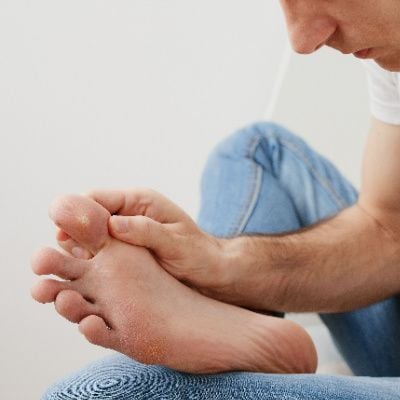 Plantar warts, scientifically known as Verruca plantaris, are a common dermatological concern affecting the feet' soles. These small, benign growths may seem innocuous, but for those who develop them, the experience can be discomforting. In this comprehensive guide, we delve into the intricacies of plantar warts, exploring their causes, symptoms, available treatment options, and preventive measures.
Plantar warts, scientifically known as Verruca plantaris, are a common dermatological concern affecting the feet' soles. These small, benign growths may seem innocuous, but for those who develop them, the experience can be discomforting. In this comprehensive guide, we delve into the intricacies of plantar warts, exploring their causes, symptoms, available treatment options, and preventive measures.
What Are Plantar Warts?
Plantar warts are caused by the human papillomavirus (HPV), which is a strain that thrives in warm and moist environments. When the virus enters the body through tiny cuts or breaks in the skin, it prompts the rapid growth of cells on the outer layer of the skin, leading to the formation of a wart. These warts on the soles of the feet are termed plantar warts.
Causes and Risk Factors
Several factors contribute to the development of plantar warts:
-
Direct Contact: The HPV virus responsible for plantar warts is highly contagious and can be contracted through direct contact with the virus. This commonly occurs in places with a high likelihood of exposure, such as public showers or swimming pools.
-
Weakened Immune System: Individuals with weakened immune systems, including children and those with certain health conditions, may be more susceptible to HPV infections, increasing the risk of plantar warts.
-
Skin Abrasions: Any break in the skin, such as a cut or scrape, provides an entry point for the virus, facilitating the development of plantar warts.
Symptoms of Plantar Warts
-
Small, Fleshy Growth: Plantar warts often appear as small, grainy lesions with a fleshy texture.
-
Black Dots: Tiny, black dots within the wart, often called "wart seeds," are clotted blood vessels.
-
Pain or Tenderness: Due to the pressure applied to the soles of the feet during walking or standing, plantar warts can cause pain or tenderness.
-
Hard, Thickened Skin: Surrounding skin may become stiff and thickened, particularly over the wart.
Diagnosis and Evaluation
Diagnosing plantar warts is typically a clinical process:
-
Visual Inspection: Healthcare professionals can often diagnose plantar warts through a visual examination, identifying characteristic features such as texture and appearance.
-
Dermoscopy: In some cases, dermoscopy—a non-invasive technique using a handheld instrument—may be employed to magnify and examine the wart more closely.
Management and Treatment Options
-
Topical Treatments:
- Salicylic Acid: Over-the-counter solutions containing salicylic acid can be applied to the wart, gradually breaking down the tissue.
-
Cryotherapy:
- Liquid Nitrogen: Healthcare providers may use liquid nitrogen to freeze and remove the wart.
-
Electrosurgery:
- Electrodesiccation: This involves using an electrical current to burn and remove the wart.
-
Laser Therapy:
- Pulsed Dye Laser: Laser therapy targets blood vessels within the wart, effectively destroying it.
-
Surgical Excision:
- Minor Surgery: In persistent cases, surgical wart removal may be considered.
-
Immunotherapy:
- Topical Immunotherapy: Stimulating the immune system to fight the virus causing the wart.
Preventive Measures
-
Maintain Foot Hygiene:
- Regular washing of the feet, especially after exposure to public spaces, can reduce the risk of developing plantar warts.
-
Avoid Walking Barefoot:
- Minimize direct contact with surfaces where the virus may thrive, such as public showers or pool areas.
-
Change Socks and Shoes Regularly:
- Keep feet dry and reduce the likelihood of creating a conducive environment for the virus.
-
Avoid Touching Warts:
- Refrain from picking at or scratching warts to prevent the spread of the virus.
Living with Plantar Warts: Tips and Considerations
-
Patience with Treatment:
- Wart removal treatments may take time; patience is essential for a successful outcome.
-
Foot Inspection:
- Regularly inspect your feet for any signs of new warts or changes in existing ones.
-
Seek Professional Advice:
- Consult with a healthcare professional for an accurate diagnosis and appropriate treatment plan.
Conclusion
While plantar warts can be a source of discomfort, understanding their causes, symptoms, and available treatments empowers individuals to navigate this common dermatological issue effectively. Whether opting for over-the-counter solutions, professional interventions, or preventive measures, individuals can take proactive steps to manage and prevent plantar warts. By demystifying this condition, we aim to provide a comprehensive guide to the overall well-being of those grappling with plantar warts on their journey toward healthy, pain-free feet.
Disclaimer:
The information on this website is provided for educational and information purposes only and is not medical advice. Always consult with a licensed medical provider and follow their recommendations regardless of what you read on this website. If you think you are having a medical emergency, dial 911 or go to the nearest emergency room. Links to other third-party websites are provided for your convenience only. If you decide to access any of the third-party websites, you do so entirely at your own risk and subject to the terms of use for those websites. Neither Brian Cragg, DCh, BSc (Hons), nor any contributor to this website, makes any representation, express or implied, regarding the information provided on this website or any information you may access on a third-party website using a link. Use of this website does not establish a doctor-patient relationship. If you would like to request an appointment with a health care provider, please call our office at (905) 294-8087.

















